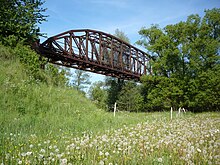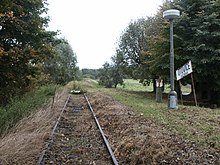Meziměstí – Ścinawka Średnia railway line
| Meziměstí – Ścinawka Średnia | |||||||||||||||||||||||||||||||||||||||||||||||||||||||||||||||||||||||||||||||||||||||||||||||||||||||||||||
|---|---|---|---|---|---|---|---|---|---|---|---|---|---|---|---|---|---|---|---|---|---|---|---|---|---|---|---|---|---|---|---|---|---|---|---|---|---|---|---|---|---|---|---|---|---|---|---|---|---|---|---|---|---|---|---|---|---|---|---|---|---|---|---|---|---|---|---|---|---|---|---|---|---|---|---|---|---|---|---|---|---|---|---|---|---|---|---|---|---|---|---|---|---|---|---|---|---|---|---|---|---|---|---|---|---|---|---|---|---|
| Course book series (SŽDC) : | 029 | ||||||||||||||||||||||||||||||||||||||||||||||||||||||||||||||||||||||||||||||||||||||||||||||||||||||||||||
| Route length: | 24.2 km | ||||||||||||||||||||||||||||||||||||||||||||||||||||||||||||||||||||||||||||||||||||||||||||||||||||||||||||
| Gauge : | 1435 mm ( standard gauge ) | ||||||||||||||||||||||||||||||||||||||||||||||||||||||||||||||||||||||||||||||||||||||||||||||||||||||||||||
| Route class : | C3 | ||||||||||||||||||||||||||||||||||||||||||||||||||||||||||||||||||||||||||||||||||||||||||||||||||||||||||||
| Top speed: | 60 km / h | ||||||||||||||||||||||||||||||||||||||||||||||||||||||||||||||||||||||||||||||||||||||||||||||||||||||||||||
|
|||||||||||||||||||||||||||||||||||||||||||||||||||||||||||||||||||||||||||||||||||||||||||||||||||||||||||||
The Meziměstí – Ścinawka Średnia railway was a railway connection between today's Czech Republic and Poland , which was originally built and operated as the main line by the privileged Austro-Hungarian State Railway Company (StEG) . It runs from Meziměstí ( Halbstadt ) via Broumov ( Braunau ) to Ścinawka Średnia ( Mittelsteine ).
Only the Meziměstí – Broumov section is in operation today; cross-border traffic was discontinued in 1953. Between Tłumaczów and Ścinawka Średnia, the line has been used as a non-public connecting railway since July 2010 after a long period of shutdown.
history
Prehistory and construction
On September 14, 1872, the kk priv. Austrian State Railway Company “got the right to build and operate a locomotive railway from Chotzen to Neusorge with connections on the one hand via Braunau to Neurode, on the other hand towards Waldenburg with a branch line from the Nachod – Neustadt line to a suitable one Point of the south-north German connecting railway "granted. Part of this concession was the obligation to provide a second track " if the annual gross profit for two consecutive years exceeds the sum of 180,000 fl. Austrian currency ". The concessionaire was also obliged to start construction within six months of the granting of the concession and to “hand over the completed railway to public transport” within three years .
The crossing tracks in the stations were given a usable length of 330 meters. This allowed trains with up to 70 cars to run.
On July 15, 1875, the main connection from Chotzen via Halbstadt to Braunau was opened. A year later - on July 26, 1876 - the short continuation to Ottendorf went into operation.
The planned route across the border towards Neurode could not be implemented there initially. In Halbstadt, too, there was initially only a provisional station, as the Prussian route to Waldenburg and Breslau was still in the planning stage. The Halbstadt train station was finally realized as an arched triangle. The station building and the platforms were only on the tracks in the direction of the state border, so that from then on all passenger trains on the Chotzen – Ottendorf route had to go crazy there. The connecting curve intended for this traffic direction was only used by freight traffic. The Breslau-Schweidnitz-Freiburg Railway Company opened the cross-border route from Niedersalzbrunn to Halbstadt on May 15, 1878.
The basis for the further construction of the line to Prussia was a state treaty between Austria-Hungary and the German Reich of March 14, 1885. It came into force in Berlin on June 5, 1885 when the ratification documents were exchanged. The Prussian government undertakes to carry out the section located on its own territory for its own account. Austria, however, assured that the StEG will complete and commission the section located on Austrian territory at the same time as the Prussian line. The existing Mittelsteine train station on the Dittersbach – Glatz line was designated as the changing station between the railway administrations . The StEG was obliged to operate the entire line; it should also be responsible for the maintenance and possible extensions of the Prussian line.
On April 5, 1889, the Ottendorf – Mittelsteine line was opened.
First years of operation
After the nationalization of the StEG on January 1, 1908, the line was transferred to the kk Staatsbahnen (kkStB). After the First World War, the newly founded Czechoslovak State Railways ČSD took their place . The first ČSD timetable from 1919 recorded two continuous pairs of passenger trains from Chotzen via Halbstadt to Mittelsteine. Further trains coming from Chotzen or Wekelsdorf (Teplice nad Metuji) already ended in Braunau. The travel time of the trains between Halbstadt and Braunau was about an hour.
In World War II
After the Sudetenland was annexed to Germany in autumn 1938, the line came to the Deutsche Reichsbahn , Reichsbahndirektion Breslau . In the imperial course book the connection was now included as course book route 155e Mittelsteine – Halbstadt – Wekelsdorf – Matha-Mohren . The timetable from 1944 contained a total of seven pairs of passenger trains running daily on the entire route, with others running between Wekelsdorf, Halbstadt and Braunau. The travel time for the 24-kilometer route was between 45 and 53 minutes. At the end of the war in May 1945, operations ceased.
The decline after World War II
After the end of the Second World War , the section located in Bohemia was returned to the ČSD. Lower Silesia became Polish territory in 1945 in accordance with the Potsdam Agreement , and the section of the route there was now owned by the Polish State Railways (PKP). The train service was initially not resumed. In 1946 the PKP removed a section of track at the border. The reason for this was the conflict between Poland and Czechoslovakia over the area of the former County of Glatz , which was claimed by Czechoslovakia as a historical state territory at that time. The interruption of the route was intended to prevent a rapid occupation of the country by Czechoslovak troops.
After the conflict was settled, the PKP used the route for privileged through traffic (PED) in the relation Ścinawka Średnia – Meziměstí– Boguszów (Mittelsteine – Halbstadt – Gottesberg), as their own parallel connection Wałbrzych – Kłodzko (Waldenburg-Dittersbach – Glatz) was not yet continuously navigable due to the war damage to tunnels and bridges. After the restoration of this line in 1953, the PED was discontinued and the tracks at the border were dismantled.
From now on, PKP only operated the Polish section in freight traffic to the loading point of the quarry in Tłumaczów. The tourist traffic was no longer taken up. On August 28, 1969, the remaining line was finally declared the connecting line of the Tłumaczów quarry. It was finally shut down at the end of the 1980s.
ČSD continued to use the route for tourist traffic up to the last stop on Czechoslovakian territory. The 1988 timetable recorded a total of 14 passenger trains between Meziměstí and Broumov, twelve of which continued to Otovice zastavka. Freight traffic was withdrawn as far as Broumov and the corresponding facilities in Otovice station were dismantled.
At the České dráhy plant
On January 1, 1993, the Czech section came to the newly founded Czech state railway organization České dráhy (ČD) in the course of the dissolution of Czechoslovakia . The 1995 timetable recorded a total of eleven pairs of passenger trains between Meziměstí and Otovice zastávka. Another five trains ran only between Mezimesti and Broumov. The trains from Choceň were not tied through at that time.
The state organization Správa železniční dopravní cesty (SŽDC) has been the railway infrastructure company since 2003 .
Travel between Broumov and Otovice zastávka was suspended on December 11, 2005. The relocation option in the new Broumov terminus has now also made it possible for some trains to pass between Broumov and Týniště nad Orlicí. This was first practiced on a larger scale in the 2007/2008 timetable. That year there were three such pairs of trains, and others ran to and from Starkoč or Trutnov .
In 2010 timetable there are weekdays between a fixed Meziměstí and Broumov Einstundentakt , weekends go at least every two hours trains. Express and passenger trains are used alternately, stopping at all intermediate stations. The express trains always run to and from Starkoč, where there is a direct connection to an express train connection to Prague. Most of the passenger trains only serve the Meziměstí – Broumov route, some of them are also connected to and from Náchod. In Ruprechtice, Hynčice and Broumov-Olivětín the trains only stop when needed.
Reconstruction between Tłumaczów and Ścinawka Średnia
In 2009, Strateg Capital Sp. Z oo announced that it would like to resume mining of Melaphyr in Tłumaczów after more than 30 years of inactivity . An annual output of 2 million tons of rock is planned. The daily output of the quarry will be 8,000 tons, an amount that can only be moved by rail.
The first plan to rebuild the railway line on the old planum to Tłumaczów called for completion by the end of March 2010. Ultimately, construction work began on the seven-kilometer section in summer 2009. In addition to the construction of the new track, all bridges had to be renewed. They were created completely new in solid wall girder construction on concrete pillars. A new station with a main track and two sidings in Ścinawka Górna was designed as the operational center. In terms of safety, the new line is equipped like a main line, the line speed is 80 km / h.
On July 30, 2010 - four months after the announced date - the new line finally went into operation. Since the loading facility in Tłumaczów has not yet been completed, the ballast produced is initially temporarily loaded with conveyor belts. The Polish railway company PKP Cargo is responsible for transporting the freight trains .
literature
- Miroslav Jelen: Zrušené železniční tratě v Čechách, na Moravě a ve Slezsku , Dokořán, Prague 2009, ISBN 978-80-7363-129-1
- Zdeněk Hudec et al: Atlas drah České republiky 2006–2007. 2nd Edition. Dopravní vydavatelství Malkus, Praha 2006, ISBN 80-87047-00-1 .
Web links
- Týniště nad Orlicí – Otovice zastávka on www.zelpage.cz
- Description of the Choceň – Broumov route
- Description (Polish)
- Description (Polish)
Individual evidence
- ↑ Reichsgesetzblatt for the kingdoms and states represented in the Reichsrathe of October 22, 1872
- ^ State treaty between Austria-Hungary and the German Empire, concerning several railway connections on the Austro-Prussian border from March 14, 1885
- ↑ ČSD timetable from 1919
- ^ German course book, annual timetable 1944/45 - valid from July 3, 1944 until further notice
- ↑ JELEN p. 132f.
- ↑ ČSD timetable 1988/89
- ↑ ČD annual timetable 1995/1996
- ↑ ČD's 1997/1998 annual timetable
- ↑ ČD annual timetable 2010
- ↑ Report on the reconstruction of the Ścinawka Średnia – Tłumaczów line on www.k-report.cz (Czech)
- ↑ homepage Strateg Capital



